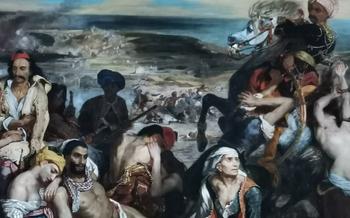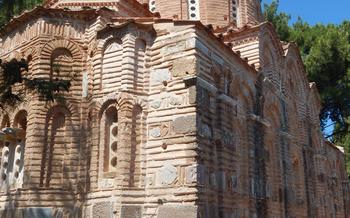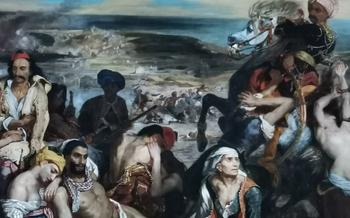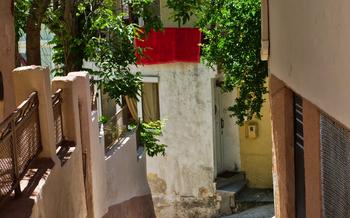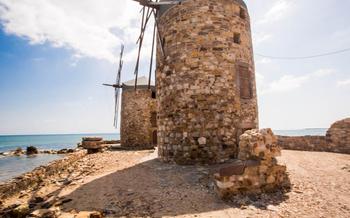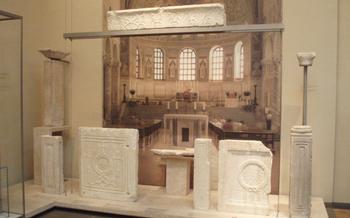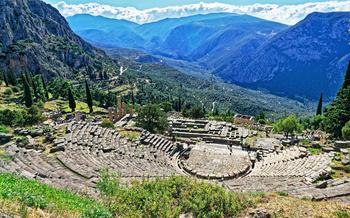
Chios Maritime Museum
- Historical Background
- Museum Location and Accessibility:
- Exhibits and Displays
- Maritime Traditions and Craftsmanship
- Naval Battles and Seafaring Adventures:
- Maritime Trade and Commerce:
- Shipwrecks and Underwater Discoveries
- Lighthouses and Coastal Navigation
- Fishing and Marine Life
- Maritime Festivals and Events
- Local Cuisine and Maritime Flavors
- Art and Literature Inspired by the Sea
- Sustainable Tourism and Marine Conservation
- Insider Tip: Unveiling the Secret Cove of Agios Isidoros
Historical Background
Chios, a picturesque island nestled in the Aegean Sea, boasts a rich maritime history that dates back centuries. During the Byzantine and Genoese eras, Chios emerged as a prominent maritime trading hub, connecting the East and West. The island's strategic location and natural harbors attracted merchants and seafarers from across the Mediterranean, contributing to its economic prosperity and cultural exchange.
The establishment of the Chios Maritime Museum in 1988 marked a significant milestone in preserving and showcasing the island's maritime heritage. Housed in a beautifully restored 18th-century mansion, the museum offers a captivating journey through the annals of Chios's seafaring past. Visitors can delve into the lives of renowned shipbuilders, witness the evolution of shipbuilding techniques, and discover tales of naval battles and seafaring adventures that shaped the island's destiny.
Museum Location and Accessibility:
The Chios Maritime Museum is conveniently located at Leof. Aigaiou 105, Chios Town, 821 00, Greece. It is situated in a historic building within walking distance from the central market and the main port. Visitors can easily reach the museum by foot, by car, or by public transportation. Paid parking is available nearby. The museum is fully accessible, with ramps, elevators, and designated parking spaces for visitors with disabilities.
Exhibits and Displays
The Chios Maritime Museum houses a fascinating collection of exhibits and displays that bring the island's maritime history to life. Step inside and embark on a journey through time, where you'll encounter scale models of traditional sailing ships, intricate navigational instruments, and maps that chart the course of Chios's maritime adventures. Gaze upon rare photographs, documents, and personal artifacts that tell the stories of seafarers, shipbuilders, and merchants who shaped the island's destiny.
Among the highlights of the museum's collection are the meticulously crafted models of ancient Greek ships, showcasing the advanced shipbuilding techniques of the past. Admire the intricate details of these miniature vessels, from their sleek hulls to their billowing sails, and imagine them gliding across the waves centuries ago. Interactive exhibits allow you to engage with the museum's collection in a hands-on way. Try your hand at knot-tying, learn about the principles of navigation, or test your skills in a simulated sailing race.
Temporary exhibitions and special collections add an ever-changing dimension to the museum's offerings. Keep an eye out for displays that showcase the latest archaeological discoveries from shipwrecks around Chios or delve into the maritime traditions of other Mediterranean cultures. Whether you're a history buff, a sailing enthusiast, or simply curious about the seafaring heritage of Greece, the Chios Maritime Museum promises an immersive and educational experience.
Maritime Traditions and Craftsmanship
Chios's maritime heritage is deeply intertwined with traditional shipbuilding techniques, tools, and materials. The island's skilled shipbuilders have passed down their knowledge and expertise through generations, creating a legacy of craftsmanship that is still evident today.
At the Chios Maritime Museum, visitors can explore the tools and techniques used by these master shipbuilders. Traditional cauldrons, adzes, and chisels are displayed alongside models of ships and intricate wood carvings. Visitors can learn about the different types of wood used in shipbuilding, such as pine, cypress, and oak, and the methods used to shape and join the planks.
The museum also showcases examples of decorative motifs and carvings that adorn traditional Chios boats. These intricate designs, often featuring marine symbols and patterns, reflect the pride and artistry of the shipbuilders. Visitors can admire the delicate scrollwork, geometric patterns, and painted decorations that bring these vessels to life.
Exploring the maritime traditions and craftsmanship of Chios offers a glimpse into the island's rich maritime heritage. It is a testament to the skill and artistry of the island's shipbuilders, who have played a vital role in shaping Chios's maritime identity.
Naval Battles and Seafaring Adventures:
Chios's strategic location in the Aegean Sea made it a contested territory throughout history, leading to numerous naval battles and seafaring adventures. In the Middle Ages, the island was a battleground between the Byzantine Empire and the Genoese Republic, with epic sea battles fought for control of the lucrative trade routes. During the Ottoman era, Chios was a haven for pirates and corsairs who raided merchant ships and engaged in daring seafaring exploits.
One of the most famous naval battles in Chios's history occurred in 1695, when a combined Venetian and Maltese fleet clashed with the Ottoman navy off the coast of the island. The battle raged for hours, with both sides suffering heavy losses. In the end, the Venetians and Maltese emerged victorious, securing their dominance in the region for several years.
Chios was also home to many skilled seafarers and navigators who embarked on long and perilous journeys. One such adventurer was Ioannis Kapodistrias, who sailed from Chios to Russia, where he served as a naval officer and later became the first Governor of Greece. His exploits and contributions to Greek independence earned him the title of "Father of the Nation."
These naval battles and seafaring adventures left an indelible mark on Chios's history and culture, shaping the island's identity as a maritime crossroads and a place of courage and resilience.
Maritime Trade and Commerce:
Chios's strategic location and natural harbors made it a bustling hub for maritime trade and commerce throughout history. The island's merchants played a vital role in connecting the Mediterranean and beyond, establishing trade routes that stretched from the Black Sea to the shores of North Africa and Europe. The city of Chios served as a marketplace for a diverse array of goods, including the island's renowned mastic gum, citrus fruits, and wine. These exports brought prosperity to the island and contributed to its cultural and economic growth.
Chios's maritime trade flourished under the rule of the Byzantine Empire, the Genoese, and the Ottomans. During the Ottoman period, the island became a major center for the production and trade of mastic gum, a valuable resin used in the production of perfumes, medicines, and confectionery. The mastic trade attracted merchants from across the Mediterranean, who flocked to Chios to purchase this prized commodity. The island's merchants formed guilds and trading networks to facilitate commerce and protect their interests.
The legacy of Chios's maritime trade can still be seen today in the island's architecture, culture, and cuisine. The old harbor of Chios Town is lined with stately mansions built by wealthy merchants, while the island's cuisine reflects the diverse influences of the many cultures that have passed through its ports. Chios's maritime heritage continues to shape the island's identity and its place in the Mediterranean world.
Shipwrecks and Underwater Discoveries
The waters surrounding Chios hold many secrets, including numerous shipwrecks that have been discovered over the years. These underwater sites offer a glimpse into the island's rich maritime past and provide valuable insights into ancient seafaring activities. One notable shipwreck is the wreck of a Roman merchant ship that sank off the coast of Chios in the 1st century AD. The ship was carrying a cargo of amphoras, pottery, and other artifacts that provide a fascinating glimpse into the trade routes and commercial activities of the Roman Empire.
Another significant discovery was the wreck of a Byzantine warship that sank near Chios in the 6th century AD. The ship was carrying a wealth of gold coins and other treasures, which have helped to shed light on the naval power and wealth of the Byzantine Empire. Underwater archaeological expeditions continue to explore the waters around Chios, uncovering new shipwrecks and artifacts that provide valuable insights into the island's maritime history. Visitors can learn more about these underwater discoveries at the Chios Maritime Museum, which displays a collection of artifacts recovered from shipwrecks and provides information on ongoing research projects.
Lighthouses and Coastal Navigation
Chios's strategic location and rugged coastline have made lighthouses essential for safe navigation in the surrounding waters. The most iconic of these is the Chios Lighthouse, situated at the southern tip of the island. Built in 1882, this stately lighthouse stands 24 meters tall and emits a powerful beam that can be seen from miles away. Its whitewashed exterior and red lantern contrast beautifully with the azure waters and rocky cliffs.
In addition to the Chios Lighthouse, several smaller lighthouses dot the island's coastline, guiding ships through treacherous channels and warning them of potential hazards. The Agios Fokas Lighthouse, located on the island's northwestern coast, is particularly picturesque, perched on a rocky outcrop overlooking the Aegean Sea.
Lighthouses have played a crucial role in the maritime history of Chios, ensuring the safe passage of merchant ships, fishing vessels, and naval fleets. They stand as silent sentinels, guiding mariners through the darkness and protecting them from the perils of the sea.
Fishing and Marine Life
Chios's rich maritime heritage extends beyond shipbuilding and trade to encompass traditional fishing practices and a diverse marine ecosystem. The island's fishermen have long relied on the sea for sustenance and income, employing various techniques such as hook-and-line fishing, nets, and traps. Their expertise and knowledge of the local waters have been passed down through generations, ensuring a sustainable and respectful approach to fishing.
The waters surrounding Chios are home to a diverse array of marine life, including a variety of fish species, dolphins, and sea turtles. The island's unique geography and underwater topography create diverse habitats, from shallow bays and sandy beaches to deep seamounts and rocky reefs. This diversity supports a thriving ecosystem that attracts both commercial and recreational fishermen, as well as marine enthusiasts and researchers.
Chios is committed to protecting its marine environment and promoting sustainable fishing practices. The island has implemented various measures to ensure the conservation of marine resources, including fishing regulations, marine protected areas, and educational programs. Visitors can contribute to these efforts by choosing to dine at restaurants that source their seafood responsibly and by avoiding the purchase of endangered or illegally caught species.
Maritime Festivals and Events
Chios's maritime heritage is celebrated through a variety of local festivals and events that showcase the island's rich traditions and vibrant culture. One of the most notable events is the annual Chios Maritime Festival, held in August. This festival is a delightful showcase of the island's maritime history, featuring traditional boat races, fishing competitions, and exhibitions of traditional shipbuilding techniques. Visitors can also enjoy live music, dancing, and a variety of local delicacies, all while soaking up the festive atmosphere.
Another popular event is the Feast of Saint Nicholas, the patron saint of seafarers, which takes place on December 6th. This religious festival is celebrated with processions, boat blessings, and traditional feasts in honor of Saint Nicholas. Visitors can join the locals in paying homage to the saint and seeking his protection for safe travels at sea.
Throughout the year, Chios hosts various other maritime-themed events, such as boat shows, regattas, and cultural exhibitions. These events provide an excellent opportunity for visitors to immerse themselves in the island's seafaring culture, learn about its history, and experience the warmth and hospitality of the local community.
Local Cuisine and Maritime Flavors
The sea has played a significant role in shaping Chios's culinary traditions, resulting in a rich and diverse cuisine that celebrates the bounty of the ocean. Fresh seafood is a staple in local dishes, with fish, squid, octopus, and shrimp featuring prominently. These ingredients are often grilled, fried, or stewed with aromatic herbs, spices, and olive oil to create flavorful dishes that showcase the island's maritime heritage.
One of the most renowned local delicacies is mastic gum, a unique resin produced by the mastic trees that grow exclusively on Chios. Mastic gum is used in a variety of culinary creations, including ice cream, pastries, and liqueurs, adding a distinct flavor and aroma to these treats.
Visitors to Chios can indulge in authentic maritime-inspired dishes at the island's many tavernas and restaurants. Along the picturesque harbor, one can savor freshly caught seafood grilled to perfection, accompanied by traditional Greek salads, tzatziki, and crusty bread. For a truly immersive culinary experience, consider joining a cooking class and learning to prepare traditional Chios dishes using local ingredients and techniques.
Art and Literature Inspired by the Sea
The sea and maritime life have been a constant source of inspiration for local artists, writers, and poets on the island of Chios. These creative minds have captured the essence of the island's maritime heritage in their works, expressing the beauty, mystery, and challenges of life by the sea.
In the realm of art, painters and sculptors have depicted the vibrant colors and textures of the sea, the grace and power of sailing ships, and the ruggedness of the island's coastline. Their works adorn galleries and museums throughout Chios, inviting visitors to immerse themselves in the island's maritime spirit.
Literature and poetry have also flourished, with local writers weaving tales of seafaring adventures, naval battles, and the lives of fishermen and sailors. These stories and poems capture the unique experiences and emotions of those who have lived and worked by the sea, providing a glimpse into the soul of Chios's maritime heritage.
One notable example is the work of the renowned Greek poet Yannis Ritsos, who spent his childhood on Chios. His poems often explored themes of the sea and its connection to human life, capturing the beauty, vastness, and mystery of the marine world.
Whether through paintings, sculptures, or the written word, the artists and writers of Chios have immortalized the island's maritime heritage, ensuring that its stories and traditions will continue to inspire and captivate generations to come.
Sustainable Tourism and Marine Conservation
Chios's maritime heritage is a valuable asset that needs to be preserved for future generations. Sustainable tourism practices play a crucial role in achieving this goal. Visitors to Chios can contribute to sustainable tourism by choosing eco-friendly accommodation and transportation options, reducing their plastic consumption, and respecting the local environment. They can also support local businesses that prioritize sustainability and give back to the community.
The island's marine ecosystems are home to a diverse array of marine life, including endangered species. Marine conservation efforts are essential to protect these ecosystems and ensure the long-term sustainability of Chios's maritime heritage. Visitors can contribute to marine conservation by avoiding activities that harm marine life, such as littering or collecting shells and corals. They can also support local organizations involved in marine conservation and research.
By embracing sustainable tourism practices and supporting marine conservation efforts, visitors to Chios can help preserve the island's maritime heritage while enjoying its unique attractions.
Insider Tip: Unveiling the Secret Cove of Agios Isidoros
Beyond the bustling harbor and well-trodden tourist spots, Chios holds a hidden gem that encapsulates the essence of its maritime heritage – the secluded cove of Agios Isidoros. Nestled along the island's rugged eastern coast, this picturesque haven is a sanctuary for those seeking tranquility and a glimpse into the island's past.
To reach this hidden gem, embark on a scenic drive along the winding coastal road, passing through charming villages and olive groves. As you approach Agios Isidoros, the landscape transforms into a breathtaking panorama of turquoise waters, dramatic cliffs, and lush vegetation.
Park your car and follow a narrow path that leads down to the cove. As you descend, the salty sea breeze fills the air, carrying with it the scent of wild herbs and the sound of crashing waves.
Upon reaching the cove, you'll be greeted by a secluded beach with crystal-clear waters, ideal for swimming, snorkeling, and diving. Explore the underwater world and discover a vibrant ecosystem teeming with colorful fish, sea urchins, and the occasional octopus.
As you bask in the sun's warmth and the tranquility of this hidden paradise, let your imagination wander back in time. Picture the ancient Greek sailors seeking refuge in this cove during their long voyages, or the medieval merchants exchanging goods on these shores.
Agios Isidoros is more than just a beach; it's a living testament to Chios's rich maritime history, waiting to be explored by those willing to venture off the beaten path. So, pack a picnic, bring your snorkel gear, and immerse yourself in the beauty and serenity of this hidden gem.

